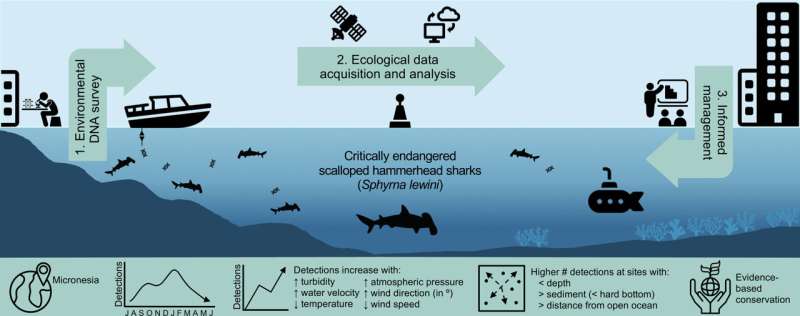Graphical abstract. Credit: Biological Conservation (2022). DOI: 10.1016/j.biocon.2022.109881
Researchers at James Cook University who paired a revolutionary method for detecting fish with freely available ecological data believe the technique could transform environmental science.
Dr. Alyssa Budd, who led the work at JCU, said scientists demonstrated the power of combining environmental DNA (eDNA) testing techniques with publicly available oceanographic and atmospheric information to perform a cost-effective wildlife survey.
The researchers investigated the distribution of critically endangered scalloped hammerhead sharks on the coast of Guam in the Marianas Island chain.
"eDNA is DNA released by species into their surrounding environment from processes like excretion and shedding. The DNA is then extracted from a sample of that environment (e.g., water, soil or even air) and can be used to indicate a species presence or absence.
"Essentially, we have been collecting and filtering large amounts of seawater, and then testing the filters to see if we caught any hammerhead DNA on them," said Dr. Budd.
Collaborating researchers from the University of Guam collected eDNA samples from Apra Harbor, monthly, over 18 months.
"We combined this with ecological data from organizations such as the US National Oceanic and Atmospheric Administration (NOAA), the European Space Agency and Google Earth Engine and then used freely available software such as QGIS and RStudio to do the analyses," said Dr. Budd.
She said eDNA sampling is non-invasive, cost-effective, rapid and remarkably accurate, with eDNA surveys like these set to revolutionize marine biodiversity monitoring.
"We have ocean observation systems and satellite remote sensing technologies that have vastly improved in recent years. Providing ecological information in unprecedented detail which allows us to put the eDNA results in context," said Professor Jan Strugnell, a senior author on the study.
She said the hammerhead survey found the presence of the sharks in the area is associated with increased water movement, turbidity, and wind direction, as well as decreased temperature and wind speed. Increased distance from the harbor entrance and shallow water were also associated.
"Scalloped hammerheads are a formerly abundant, wide-ranging shark species now classified as critically endangered. But all previous information on their presence in the Marianas was based on personal observations, or other anecdotal evidence," said Professor Strugnell.
She said the research provides an example of how innovative monitoring methods can now be used to efficiently, reliably and cheaply generate distribution data for rare and threatened species.
"Using these tools, we are now able to get the data we need to create informed management strategies and help minimize negative anthropogenic impacts on threatened species and their habitats," said Dr. Budd.
The work is published in the journal Biological Conservation.
More information: Alyssa M. Budd et al, Monitoring threatened species with environmental DNA and open ecological data: Local distribution and habitat preferences of scalloped hammerhead sharks (Sphyrna lewini), Biological Conservation (2022). DOI: 10.1016/j.biocon.2022.109881
Journal information: Biological Conservation
Provided by James Cook University
























